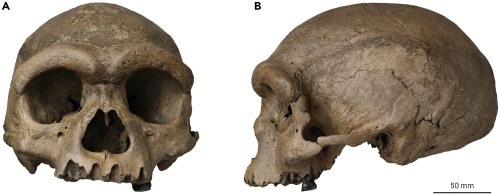At least, I’m pretty sure.
That’s Homo longi, or Dragon Man, a recently rediscovered fossil from China. It has a curious history.
Almost 90 years ago, Japanese soldiers occupying northern China forced a Chinese man to help build a bridge across the Songhua River in Harbin. While his supervisors weren’t looking, he found a treasure: a remarkably complete human skull buried in the riverbank. He wrapped up the heavy cranium and hid it in a well to prevent his Japanese supervisors from finding it. Today, the skull is finally coming out of hiding, and it has a new name: Dragon Man, the newest member of the human family, who lived more than 146,000 years ago.
Here, take a tour of the skull with Chris Stringer:
That is a big head-bone! The most provocative idea about it is that it might be one of the mysterious Denisovans, known only from DNA and fragmentary teeth.
I’ve been so deeply steeped in spider lore lately, though, that my perspective has shifted to finding it hard to believe in species anymore anyway. It’s cool to see that humans were also a diverse clade with subtle variants 150,000 years ago, almost as messy and complicated as, say, the Tetragnatha.



Look at the brow ridges on that skull.
It wouldn’t surprise me if it was Neanderthal or more likely Denisovan.
It’s in great shape for being 146,000 years old.
@raven
I social media Chris Stringer (who made this video, and was on the original paper) has expressed support for the idea that a) this is the same as skulls already named Homo daliensis (and thus H. longi is a junior synonym) and b) that it is a Denisovan. However, when you are the minority voice in a multiauthor paper, you need to accept the will of the other authors (at least for that paper).
*In, not I (jeez, typo in the VERY FIRST WORD…)
Very interesting news! I also quite enjoyed the video, even though I am not at all well-versed in paleoanthropology (or human anatomy, for that matter).
Anthropologists are notorious ‘splitters’ taxonomically. Every new specimen gets a new name.
Ernst Mayr’s “Biological Species Concept” still largely reigns when determining what populations are or are not separate species. (At least for sexually reproducing organisms).
I.e., populations that interbreed and produce fertile offspring are the same species. Full stop.
Modern humans are well known to contain non-trivial amounts of Neanderthal and Denisovan DNA.
We are all one species FFS.
“Subspecies” or “races” maybe? Heh heh. There’s a can of worms. Save that discussion for grad school.
Not going there.
Snidely: the fact that the known neanderthal genes in modern humans are all nuclear DNA, with no mitochondrial contribution. This indicated there was probably reduced fertility amongst at least the first generation crosses, so a strong argument can be made that they were a separate species.
michaelcrichton:
It is a pretty universal assumption that population numbers for Neanderthals were much lower than moderns.
If they were 100% interfertile, the percentage of descendants with Neanderthal mitochondria would have always been low.
Disappearance of these lines would be predictable without inferring reduced fertility (which alone is not a defining character for a species. Reduced fertility can come in degrees. e.g. 90% reduction: you might have an argument, 10%: not so much).
As I’m sure you know, mitochondrial genes don’t have the ‘option’ to cross over and recombine and persist in ‘diluted’ form like autosomal genes. It’s inheritance is “all or none”. In a genetically swamped situation, their absence in modern populations is not surprising. I see no persuasive evidence for reduced fertility.
Yeah, nah. Needs more work.